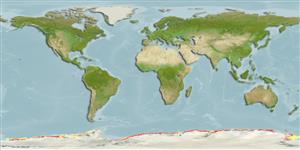>
Perciformes/Notothenioidei (Icefishes) >
Nototheniidae (Cod icefishes) > Trematominae
Etymology: Trematomus: Greek, trematos = hole + Greek, tomo = section, cut (Ref. 45335); nicolai: Named after Nicolai Hanson, biologist and collector of Southern Cross fishes, died at Cape Adare during the expedition (Ref. 11892).
More on author: Boulenger.
Issue
The genus Pseudotrematomus is a synonym of Trematomus, which is confirmed by a molecular study to be published (J.-C. Hureau, pers. comm. 08 Jun. 2010).
Environment: milieu / climate zone / depth range / distribution range
Ekologi
laut dasar (demersal); kisaran kedalaman 1 - 420 m (Ref. 11892). Polar; 65°S - 78°S
Southern Ocean: East Antarctica (some localities), but not from the Peninsula region and westward to the Ross Sea. Coasts of Adelie Land, Davis, Weddell, South Shetland and South Orkney Islands.
Size / Weight / umur
Maturity: Lm ? range ? - ? cm
Max length : 36.0 cm TL jantan/; (Ref. 5179); Berat maksimum terpublikasi: 0.00 g
deskripsi pendek
Morfologi | Morfometrik
Duri punggung (Keseluruhan (total)): 4 - 5; Sirip dubur lunak: 31 - 35. Body brownish, more or less distinct dark crossbars, scattered small dark spots, fins dusky, spiny dorsal blackish (Ref. 11892).
A nearshore benthic species usually abundant in shelf waters of East Antartica (Ref. 122792). Adults feed primarily on amphipods, other fishes, and molluscan larvae, with lesser amount of polychaetes and mysids. They capture some prey in the water column, but are not cryopelagic.
Dewitt, H.H., P.C. Heemstra and O. Gon, 1990. Nototheniidae. p. 279-331. In O. Gon and P.C. Heemstra (eds.) Fishes of the Southern Ocean. J.L.B. Smith Institute of Ichthyology, Grahamstown, South Africa. (Ref. 5179)
Status IUCN Red List (Ref. 130435)
ancaman kepada manusia
Harmless
penggunaan manusia
Warning: mysqli::__construct(): (HY000/1040): Too many connections in /var/www/html/includes/func_getlabel.php on line 46
Can't connect to MySQL database (fbapp). Errorcode: Too many connections
